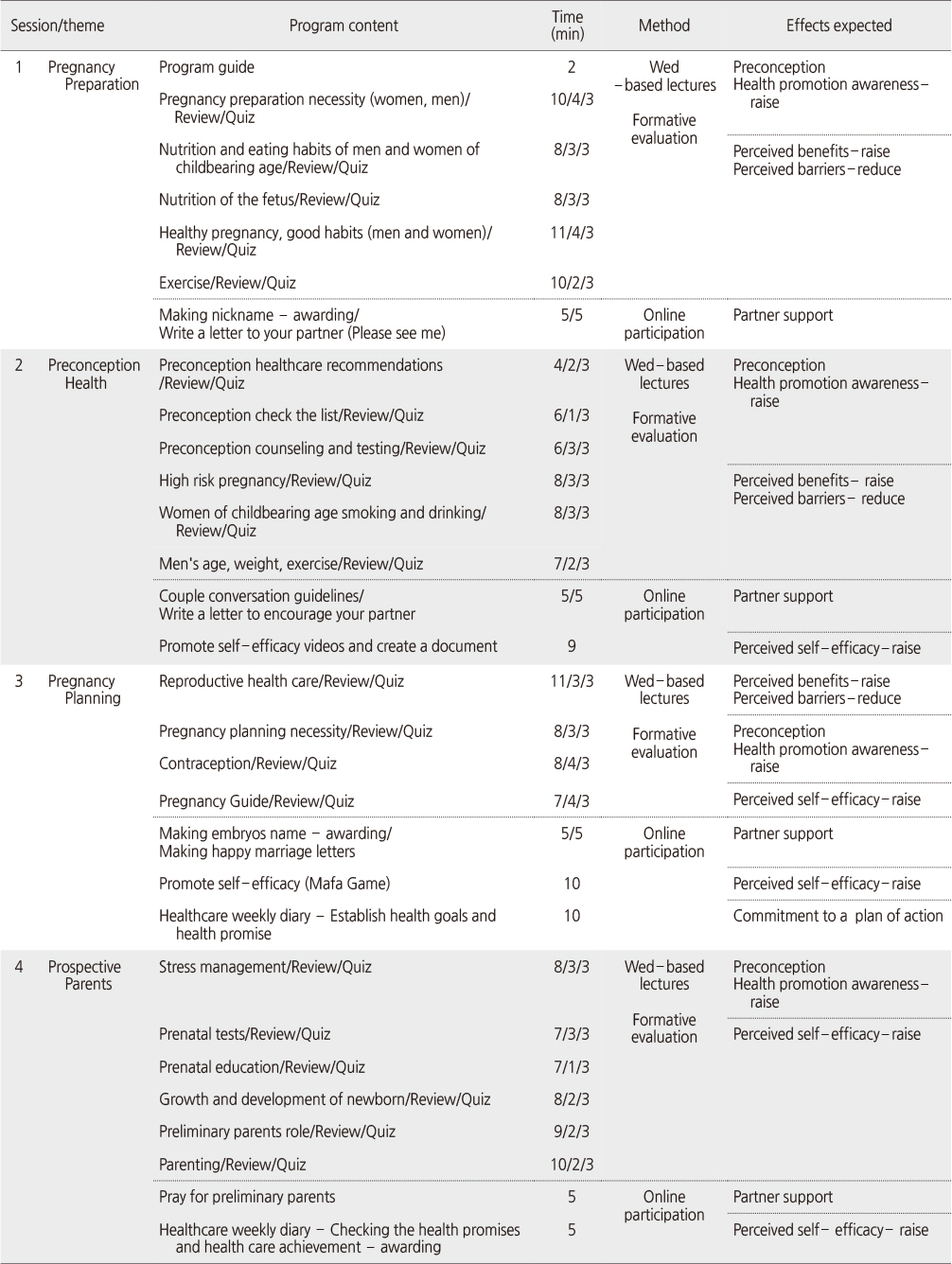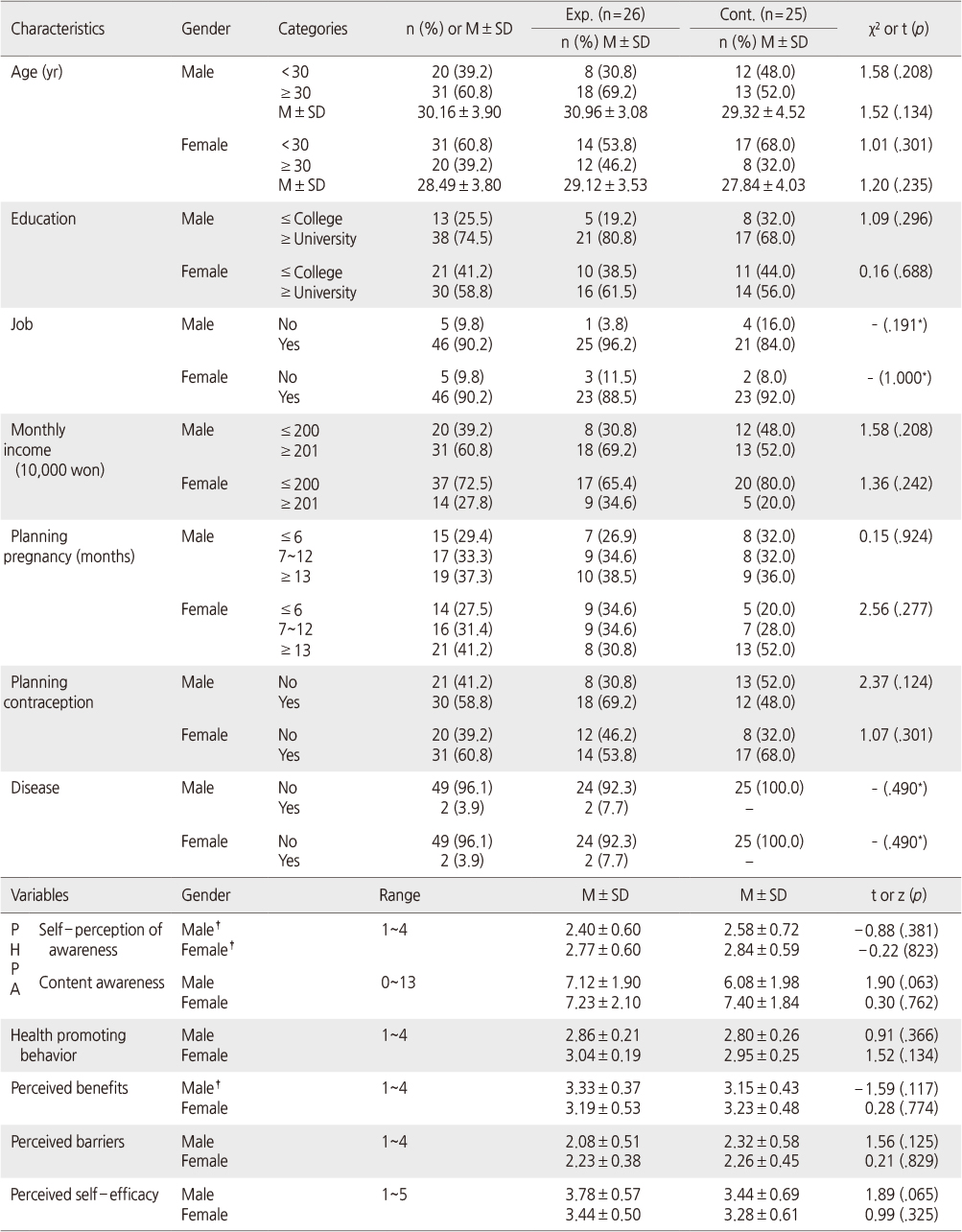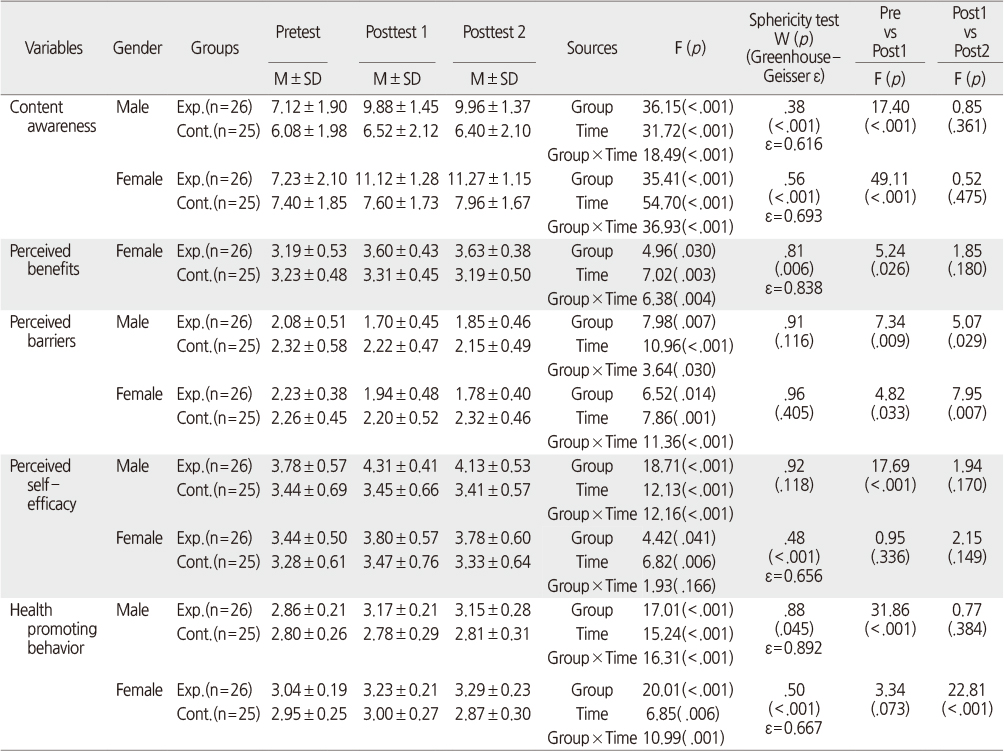Articles
- Page Path
- HOME > J Korean Acad Nurs > Volume 46(5); 2016 > Article
-
Original Article
- Effects of Web-based Preconception Health Promotion Program for Couples about to be Married
- Nam Joo Je, So Young Choi
-
Journal of Korean Academy of Nursing 2016;46(5):720-732.
DOI: https://doi.org/10.4040/jkan.2016.46.5.720
Published online: October 31, 2016
1Department of Nursing, Gyeongju University, Gyeongju, Korea.
2College of Nursing·Institute of Health Science, Gyeongsang National University, Jinju, Korea.
- Address reprint requests to: Choi, So Young. College of Nursing, Institute of Health Science, Gyeongsang National University, 816-15, Jinjudaero, Jinju, Gyeongnam 52727, Korea. Tel: +82-55-772-8241, Fax: +82-55-772-8209, css4214@gnu.ac.kr
© 2016 Korean Society of Nursing Science
This is an Open Access article distributed under the terms of the Creative Commons Attribution NoDerivs License. (http://creativecommons.org/licenses/by-nd/4.0/) If the original work is properly cited and retained without any modification or reproduction, it can be used and re-distributed in any format and medium.
Abstract
-
Purpose
- This study was done to develop a Web-based preconception health promotion program to improve preconception health promotion awareness, perceived benefits, perceived self-efficacy and health behavior, and to reduce perceived barriers in couples about to be married.
-
Methods
- Participants were assigned to the experimental group (n=26 couples) or control group (n=25 couples). This program was comprised of a six hour Web-based lecture series which was given to the experimental group over a four week period.
-
Results
- Results for the two groups showed: 1) a significant difference in preconception health promotion awareness in men (self-perception: z=-3.62, p <.001 content: F=18.49, p <.001) and in women (self-perception: z=-2.89, p =.004 content F=36.93, p <.001), 2) a significant difference in perceived benefits in men (z=-3.09, p =.002), and in women (F=6.38, p =.004), 3) a significant difference in perceived barriers in men (F=3.64, p =.030), and in women (F=11.36, p <.001), 4) a significant difference in perceived self-efficacy in men (F=12.16, p <.001), but no significant difference in women (F=1.93, p =.166), 5) a significant difference in health promoting behavior in men (F=16.31, p <.001), and in women (F=10.99, p =.001).
-
Conclusion
- The results of this study show that the program is an effective nursing intervention in couples about to be married. Therefore, this program can be useful in encouraging health-promoting behavior for couples about to be married.
*This manuscript is based on a part of the first author’s dissertation from Gyeongsang National University
- 1. Statistics Korea. Final results of birth statistics in 2014 [Internet]. Daejeon, Author. 2014;cited 2015 February 26. Available from: http://kostat.go.kr/portal/eng/pressReleases/8/10/index.board?bmode=read&aSeq=348278
- 2. Ko HS, Park IY, Shin JC. Pre-pregnancy lifestyle of couple for a healthy pregnancy. J Korean Med Assoc. 2011;54(8):825–831. Article
- 3. Park MI. Importance of preconception care in low-fertility society of Korea. J Korean Med Assoc. 2011;54(8):796–798. Article
- 4. Delgado CE. Undergraduate student awareness of issues related to preconception health and pregnancy. Matern Child Health J. 2008;12(6):774–782. ArticlePubMedPDF
- 5. Lee SR, Park JY, Ahn LS, Kim KY. Report No.: 2013-2-2. The status of preconceptional care and policy recommendations. Sejong: Korea Institute for Health and Social Affairs; 2013.
- 6. Lee SR, Lim JY, Lee EJ, Cho YT, Ra CK.. Report No.: 2014-1-2. Preconception care and policy recommendations for unmarried women of childbearing age: Focusing on medical service use and online reproductive health information. Sejong: Korea Institute for Health and Social Affairs; 2014.
- 7. Ahn S, Park I, Han JS, Kim TI, Kwak MS, Chung HS. Health behaviors, reproductive health history, and sexual behaviors of college students. Korean J Women Health Nurs. 2008;14(3):205–212.ArticlePDF
- 8. Pender NJ, Pender AR. Health promotion in nursing practice. . Stamford, CT: Appleton & Lange; 1996. p. 1–320.
- 9. Je NJ, Choi SY. Study on awareness of preconception care and reproductive health behaviors in pre-honeymooners. Korean J Women Health Nurs. 2015;21(2):71–82. ArticlePubMed
- 10. Murray E. Web-based interventions for behavior change and self-management: Potential, pitfalls, and progress. Med 2 0. 2012;1(2):e3ArticlePubMedPMC
- 11. Chung YC, Lee GH, Kim SJ, Yoo J. Report No.: 2010-39. 2010 Development and operation of gateway system for internet health information. . Seoul: Korea Institute for Health and Social Affairs; 2010.
- 12. Wang HJ, Kim IO. Effects of a mobile web-based pregnancy health care educational program for mothers at an advanced maternal age. J Korean Acad Nurs. 2015;45(3):337–346. ArticlePubMedPDF
- 13. Park MJ. Development of a web-based, tailored postpartum information program [master’s thesis]. Seoul, Yonsei University. 2007;1–95.
- 14. Chung HK, Song SH, Kang HK, Lee WH, Song SH, Kang NM. Application of the pregnancy, childbirth, breast-feeding UCC and web_based tailored pre-parental educational system among university students. J Korea Des Forum. 2012;34:347–356.
- 15. Park MN, Choi SY. Development of reproductive health program and identification of effect for married women immigrants. J Korean Acad Nurs. 2014;44(3):248–258. ArticlePubMed
- 16. DeJoy SB. Pilot test of a preconception and midwifery care promotion program for college women. J Midwifery Womens Health. 2014;59(5):523–527. ArticlePubMedPDF
- 17. Choi YS. The development of web-based ventilator management education program. J Korea Acad Ind Coop Soc. 2012;13(11):5284–5291. Article
- 18. Faul F, Erdfelder E, Buchner A, Lang AG. Statistical power analyses using G*Power 3.1: Tests for correlation and regression analyses. Behav Res Methods. 2009;41(4):1149–1160. ArticlePubMedPDF
- 19. Moon JS. A study of instrument development for health belief of Korean adults [dissertation]. Seoul, Yonsei University. 1990;1–113.
- 20. Paek YM. Prediction model on health promotion behaviors in male office workers [dissertation]. Seoul, Ewha Womans University. 2005;1–129.
- 21. Sherer M, Maddux JE, Mercandante B, Prentice-Dunn S, Jacobs B, Rogers RW. The self-efficacy scale: Construction & validation. Psychol Rep. 1982;51(2):663–671. ArticlePDF
- 22. Jo HY, Hae KY, Son HM. Development of a scale to measure reproductive health promoting behavior of undergraduates. Korean J Health Educ Promot. 2014;31(5):29–43. Article
- 23. Agricola E, Pandolfi E, Gonfiantini MV, Gesualdo F, Romano M, Carloni E, et al. A cohort study of a tailored web intervention for preconception care. BMC Med Inform Decis Mak. 2014;14:33–42. ArticlePubMedPMCPDF
- 24. Delgado C. Pregnancy 101: A call for reproductive and prenatal health education in college. Matern Child Health J. 2013;17(2):240–247. ArticlePubMedPDF
- 25. Nam TW, Chung JY. A new paradigm for subject-oriented service system of university library. J Korean Libr Inf Sci Soc. 2003;34(2):163–185.
- 26. Kim GH, Yoon HS. The effect of a health promotion program through multi-level health promotion. J Korean Acad Community Health Nurs. 2010;21(1):92–100. Article
- 27. Park KY, Kim SH. The effects of breast self-examination program enriched environmentally among healthy women. Korean J Women Health Nurs. 2010;16(2):105–115. ArticlePubMed
- 28. Seo IJ, Park JS. Development and application of a health promotion program for marriage immigrant women. Korean J Adult Nurs. 2015;27(2):198–210. ArticlePDF
- 29. Lee KJ, Chang CJ, Yoo JH. Effects of a health promoting education program on selfe-fficacy, knowledge of health management and health promoting behavior for middle-aged women. J Korean Community Nurs. 2004;15(4):577–586.
- 30. Milan JE, White AA. Impact of a stage-tailored, web-based intervention on folic acid-containing multivitamin use by college women. Am J Health Promot. 2010;24(6):388–395. ArticlePubMed
REFERENCES
Differences between Groups in Preconception Health Promotion Awareness (self-perception awareness) and Perceived Benefits between Groups (N=102)

Figure & Data
REFERENCES
Citations

- Internet-Based Interventions for Preventing Premature Birth in Preconceptional Women of Childbearing Age: Systematic Review
Sun-Hee Kim, Sun-Young Jung, Jin-Hwa Park, Jennie C De Gagne
Journal of Medical Internet Research.2025; 27: e60690. CrossRef - Development and Evaluation of a Mobile Web-based Food Allergy and Anaphylaxis Management Educational Program for Parents of School-aged Children with Food Allergy: A Randomized Controlled Trial
Hwayoung Kwen, Pok-Ja Oh
Asian Nursing Research.2022; 16(5): 265. CrossRef - Development and Application of a Web-based Integrated Support Service Program for Infertile Women
Jummi Park, Nayeon Shin
INQUIRY: The Journal of Health Care Organization, Provision, and Financing.2021;[Epub] CrossRef
Contents of Web-based Preconception Health Promotion Program
Homogeneity Test of General Characteristics and Variables (N=102)
*Fisher’s exact test; †Mann-Whitney test; PHPA=Preconception health promotion awareness.
Differences between Groups in Preconception Health Promotion Awareness (self-perception awareness) and Perceived Benefits between Groups (N=102)
Exp.=Experimental group; Cont.=Control group; Posttest 1=Right after intervention trails ended; Posttest 2=4 weeks after intervention trails ended
Mann-Whitney test: =0.025
Differences in Preconception Health Promotion Awareness (content awareness), Perceived Benefits, Perceived Barriers and Perceived Self-Efficacy and Health Promoting Behavior between Groups (N=102)
Exp.=Experimental group; Cont.=Control group; Posttest 1=right after intervention trails ended; Posttest 2=4 weeks after intervention trails ended
*Fisher’s exact test; †Mann-Whitney test; PHPA=Preconception health promotion awareness.
Exp.=Experimental group; Cont.=Control group; Posttest 1=Right after intervention trails ended; Posttest 2=4 weeks after intervention trails ended Mann-Whitney test: =0.025
Exp.=Experimental group; Cont.=Control group; Posttest 1=right after intervention trails ended; Posttest 2=4 weeks after intervention trails ended
 KSNS
KSNS
 E-SUBMISSION
E-SUBMISSION



 Cite
Cite

